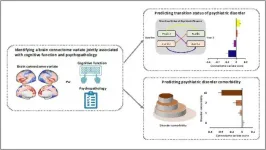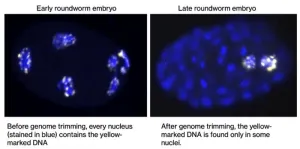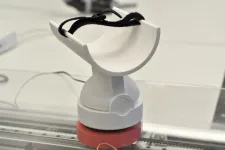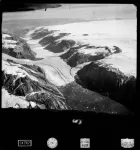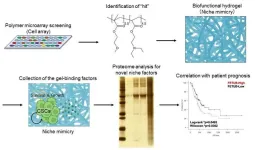(Press-News.org) ITHACA, N.Y. -- Synthetic polymers are everywhere in our society – from nylon and polyester clothing to Teflon cookware and epoxy glue. At the molecular level, these polymers’ molecules are made of long chains of monomer building blocks, the complexity of which increases functionality in many such materials.
In particular, copolymers, which consist of different types of monomers in the same chain, allow for fine-tuning of the material’s properties, said Peng Chen, the Peter J.W. Debye Professor of Chemistry in the College of Arts and Sciences (A&S). The monomer sequence plays a critical role in a material’s properties, but scientists until now have lacked a method for sequencing synthetic copolymers.
Chen and colleagues have developed CREATS (Coupled REaction Approach Toward Super-resolution imaging), which allows them to image polymerization catalysis reactions at single-monomer resolution and, through fluorescent signaling, to differentiate monomers from one another. Both are important steps in discovering the molecular composition of a synthetic polymer.
They describe the technique and the first discoveries they’ve made with it in “Optical Sequencing of Single Synthetic Polymers,” published Nov. 9 in Nature Chemistry.
Co-lead authors are Rong Ye, Xiangcheng Sun and Xianwen Mao, all former postdoctoral researchers in the Chen group. Co-authors are former Chen group postdoctoral researchers Susil Baral and Chunming Liu, current postdoctoral researcher Felix Alfonso, and Geoffrey Coates, the Tisch University Professor in chemistry and chemical biology (A&S).
“Synthetic polymers are made of monomer units linked together like a string of beads,” Chen said. In the simplest polymers, the monomers are identical, but more complex properties arise when polymers contain monomers of different sorts – called copolymers. The precise arrangement of the monomers in a copolymer plays an important role in its properties, such as stiffness or flexibility.
Sequence plays a role in the properties of natural polymers, too, Chen said. A protein, for example, is made of 20 amino acid monomers arranged in a very specific sequence.
“In a natural polymer, nature has control,” Chen said. “In synthetic polymers, humans are making the arrangements, and the chemists generally don’t have that precise control.”
Sequencing copolymers is so difficult in large part because of heterogeneity in synthetic polymers, Chen said. Individual chains differ in length, composition and sequence, which requires single-polymer sequencing methods that can resolve and identify individual monomers.
Some modern methods allow scientists to control the arrangement of monomers in a chain, Chen said, but only for very short polymers – 10 to 20 monomers long.
Using CREATS, the researchers can determine the sequence of a polymer as it is made, one monomer at a time, by imaging and identifying every single monomer as it is added to the polymer. To make the monomers visible, CREATS couples the polymerization reaction with another reaction that produces fluorescent signals.
“Every monomer that goes in gives off a puff of light,” Chen said. “The light is induced by a laser, and the puff of light has a color. In our case, it’s either green or yellow. By seeing whether it’s yellow or green, we see what monomer goes in.”
The lab is already equipped to measure synthetic polymer properties. Now that they can determine the sequence of an individual polymer, a next step is to combine the two experiments to correlate structure and function, ultimately providing guiding principles for polymer design to achieve certain properties.
“If you know how sequence controls property, you can really think about designing whatever sequence you want to achieve a certain property,” Chen said. “This knowledge presumably can help people tailor their materials for a desired application.”
The research was funded by the Polymer Chemistry program of Army Research Office, a directorate of the U.S. Army Combat Capabilities Development Command Army Research Laboratory.
-30-
END
Cornell chemists image basic blocks of synthetic polymers
2023-11-09
ELSE PRESS RELEASES FROM THIS DATE:
Brain imaging identifies biomarkers of mental illness
2023-11-09
Philadelphia, November 9, 2023 – Research and treatment of psychiatric disorders are stymied by a lack of biomarkers – objective biological or physiological markers that can help diagnose, track, predict, and treat diseases. In a new study, researchers use a very large dataset to identify predictive brain imaging-based biomarkers of mental illness in adolescents. The work appears in Biological Psychiatry, published by Elsevier.
Traditionally, psychiatric disorders such as depression have been diagnosed based on symptoms according to subjective assessments. The identification of biomarkers to aid in diagnosis and treatment selection would greatly advance treatments.
In ...
Cary Institute partners on $3M USDA-funded study on COVID-19 variants that could emerge from wildlife
2023-11-09
Many wild animals can carry COVID-19, including those that live among us, such as deer mice, red foxes, white-tailed deer, and more. These species may act as reservoirs, offering new opportunities for the virus to mutate and spill back into people. The omicron variant, for example, is thought to have emerged from mice.
With $3 million in federal grant funding, a new five-year research project will bring together virology, disease ecology, and artificial intelligence to better understand how SARS-CoV-2 (the virus that causes COVID-19) behaves ...
The enigma of embryonic development: How certain animals trim their genomes
2023-11-09
New research is underway to decipher a fascinating biological puzzle—how some animals can naturally discard more than half of their genetic information during embryonic development.
This radical natural phenomenon has captivated scientists for over 130 years, presenting a tantalizing question in the field of developmental biology and genetics.
Equipped with the latest in genetic engineering tools, the team at The University of Warwick is working to dissect the mechanisms behind this selective genomic editing. By uncovering the processes that allow some nematode worms to abandon up to ...
New URI lab developing adaptive technology, secures National Science Foundation grant
2023-11-09
New URI lab developing adaptive technology, secures National Science Foundation grant
Reza Abiri and Yalda Shahriari receive National Science Foundation award totaling $460,000 for work to improve stroke patient rehabilitation
Passing by Reza Abiri’s office at the University of Rhode Island, one might suspect him of nursing a serious coffee habit. A colorful collection of various mugs and cups dot his office, and though he is friendly enough to likely welcome any visitors stopping by to chat, the cups serve a larger purpose.
Abiri and Yalda Shahriari, professors in ...
MD Anderson announces Institute for Data Science in Oncology to advance mission to end cancer
2023-11-09
HOUSTON ― The University of Texas MD Anderson Cancer Center today announced the launch of its Institute for Data Science in Oncology (IDSO), which integrates the most advanced computational and data science approaches with the institution’s extensive scientific and clinical expertise to significantly improve patient’s lives by transforming cancer care and research.
Bringing top data scientists from a variety of fields together with clinicians and cancer scientists, the institute builds on MD Anderson’s culture of collaboration and connectivity to tackle the field’s most pressing needs in new and innovative ways. IDSO’s efforts have been catalyzed by philanthropic ...
Researchers decipher the mechanism by which the MAF protein promotes breast cancer metastasis
2023-11-09
The MAF protein interacts with the estrogen receptor, alters its function, and promotes the spread of cancer.
The KDM1A enzyme plays a fundamental role in the epigenetic remodelling that facilitates the function of pro-metastatic genes.
The work carried out in Dr. Roger Gomis Lab at IRB Barcelona has been published in the journal Nature Cell Biology.
Barcelona, 9 November 2023 – Breast cancer is the most common form of cancer among women, with more than 2 million new cases diagnosed each year. In cases where the tumour remains localised in the breast, survival rates are remarkably high, ...
New research: Fivefold increase in the melting of Greenland's glaciers over the last 20 years
2023-11-09
New research: Fivefold increase in the melting of Greenland's glaciers over the last 20 years
In the largest survey of its kind ever conducted, using both satellite imagery and old aerial photos from the Danish National Archives, researchers from the University of Copenhagen firmly establish that Greenland’s glaciers are melting at an unprecedented pace. Melting has increased fivefold in the past 20 years. The study eliminates any lingering doubts about the impact of climate change on Greenland's more than 20,000 glaciers.
Based on the most comprehensive monitoring ...
Drug screen points toward novel diabetes treatments
2023-11-09
A drug currently in clinical trials as a cancer therapy can also stimulate pancreatic beta cells to secrete insulin, revealing a previously unknown mechanism for insulin regulation in type 2 diabetes, according to a new study by Weill Cornell Medicine investigators. The preclinical discovery, reported Nov. 9 in Nature Chemical Biology, provides a new chemical tool for probing the biology of diabetes, and could point the way toward better treatments for the disease.
“We have known about insulin for a century, but when it comes to the major mechanisms controlling insulin secretion, there ...
Team creates synthetic enzymes to unravel molecular mysteries
2023-11-09
A University of Texas at Dallas bioengineer has developed synthetic enzymes that can control the behavior of the signaling protein Vg1, which plays a key role in the development of muscle, bone and blood in vertebrate embryos.
The team of researchers is using a new approach, called the Synthetic Processing (SynPro) system, in zebrafish to study how Vg1 is formed. By learning the molecular rules of signal formation in a developing animal, researchers aim to engineer mechanisms — such as giving cells new instructions — that could play a role in treating or preventing disease.
Dr. P.C. Dave P. Dingal, assistant professor of bioengineering in the Erik Jonsson ...
Finding your niche: A synthetic cancer stem cell microenvironment
2023-11-09
Researchers from Tokyo Medical and Dental University (TMDU) report the construction of a synthetic polymer biomaterial that successfully recapitulates the pancreatic adenocarcinoma microenvironment and could be used to identify novel treatment targets
Tokyo, Japan – One of the biggest challenges in biomedical research is finding a way to capture the complexity of the human body in laboratory-based techniques, to enable them to be investigated accurately. Now, researchers from Japan report an approach for precisely imitating a key feature of aggressive cancers in the laboratory.
In a study published recently in Inflammation and Regeneration, researchers from Tokyo Medical and ...
